Objectives
By the end of this section, you will be able to:
- Write Lewis symbols for neutral atoms and ions
- Draw Lewis structures depicting the bonding in simple molecules
Previously, we have discussed the various types of bonds that form between atoms and/or ions. In all cases, these bonds involve the sharing or transfer of valence shell electrons between atoms. In this section, we will explore the typical method for depicting valence shell electrons and chemical bonds, namely Lewis symbols and Lewis structures.
Lewis Symbols
We use Lewis symbols to describe valence electron configurations of atoms and monatomic ions. A Lewis symbol consists of an elemental symbol surrounded by one dot for each of its valence electrons:

The table below shows the Lewis symbols for the elements of the third period of the periodic table.
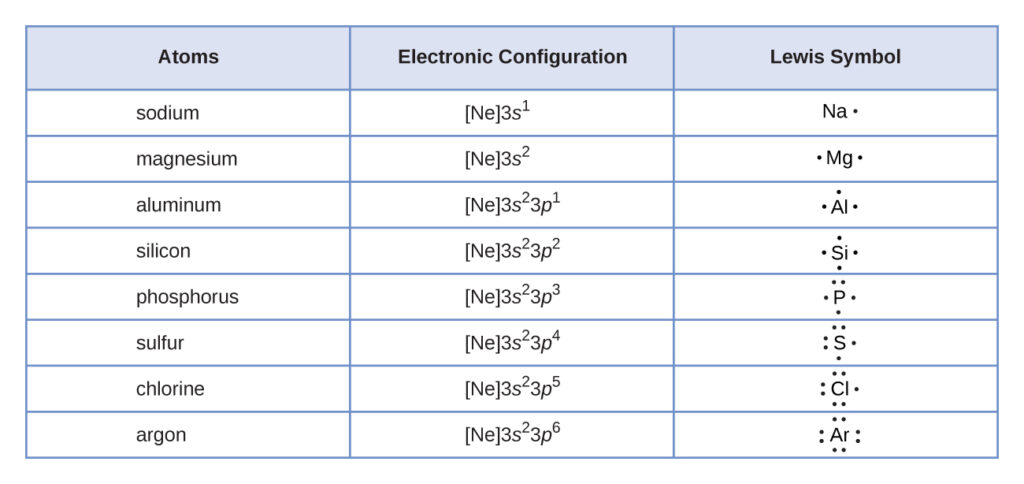
Lewis symbols can illustrate the formation of cations from atoms, as shown here for sodium and calcium:

Similarly, they can show the formation of anions from atoms, as shown here for chlorine and sulfur:

The figure below demonstrates the use of Lewis symbols to show the transfer of electrons during the formation of ionic compounds.
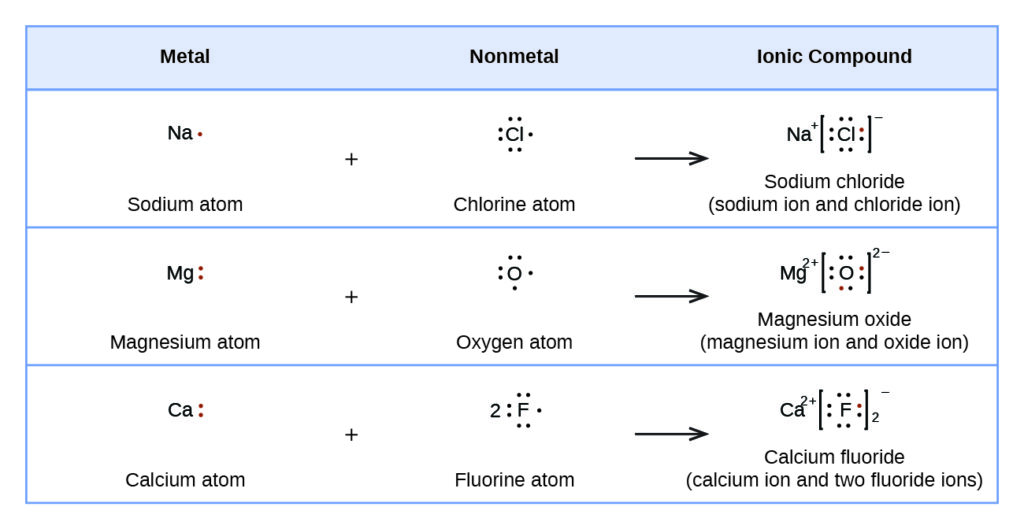
Lewis Structures
Lewis symbols indicate the formation of covalent bonds, shown in Lewis structures, which are drawings that describe the bonding in molecules and polyatomic ions. For example, when two chlorine atoms form a chlorine molecule, they share one pair of electrons:

The Lewis structure shows that each Cl atom has three pairs of electrons that are not used in bonding (called lone pairs) and one shared pair of electrons (written between the atoms). A dash (or line) is the preferred way to indicate a shared pair of electrons:

A single shared pair of electrons is called a single bond. Each Cl atom interacts with eight valence electrons: the six in the lone pairs and the two in the single bond. So the two electrons in the single bond belong to both Cls being “shared” and we count them twice, once for each octet.
The Octet Rule
The other halogen molecules (F2, Br2, I2, and At2) form bonds like those in the chlorine molecule: one single bond between atoms and three lone pairs of electrons per atom. This allows each halogen atom to have a noble gas electron configuration. The tendency of main group atoms to form enough bonds to obtain eight valence electrons is known as the octet rule.
The number of bonds that an atom can form can often be predicted from the number of electrons needed to reach an octet (eight valence electrons); this is especially true of the nonmetals of the second period of the periodic table (C, N, O, and F). For example, each atom of a group 14 element has four electrons in its outermost shell and therefore requires four more electrons to reach an octet. Forming four covalent allows an atom to gain these four electrons, as illustrated here for carbon in CCl4 (carbon tetrachloride) and silicon in SiH4 (silane):

Because hydrogen only needs two electrons to fill its valence shell, it is an exception to the octet rule. The octet rule does not apply to the transition elements and inner transition elements, so first-year course generally does not cover their bonding.
Group 15 elements such as nitrogen have five valence electrons in the atomic Lewis symbol: one lone pair and three unpaired electrons. To obtain an octet, these atoms commonly form three covalent bonds, as in NH3 (ammonia). Oxygen and other atoms in group 16 can obtain an octet by forming two covalent bonds:
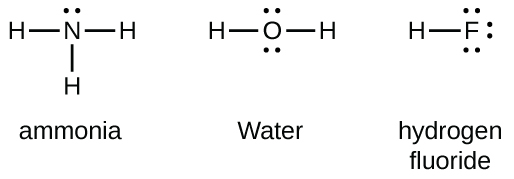
Double and Triple Bonds
As previously mentioned, when a pair of atoms shares one pair of electrons, we call this a single bond. However, a pair of atoms may need to share more than one pair of electrons in order to achieve the requisite octet. Two pairs of electrons share between a pair of atoms to form a double bond, as in the bons between the carbon and oxygen atoms in CH2O (formaldehyde) and between the two carbon atoms in C2H4 (ethylene):

A triple bond forms when a pair of atoms shares three electron pairs, as in carbon monoxide (CO) and the cyanide ion (CN–):

Writing Lewis Structures with the Octet Rule
For very simple molecules and molecular ions, we can write the Lewis structures by merely pairing up the unpaired electrons on the constituent atoms. See these examples:
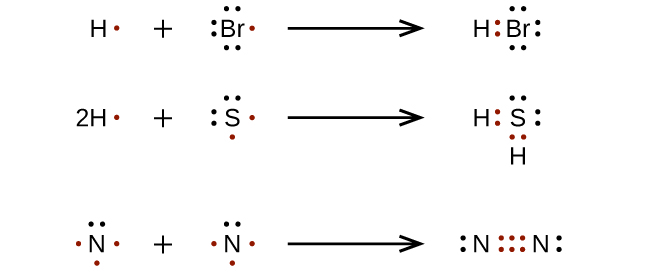
For more complicated molecules and molecular ions, it is helpful to follow the step-by-step procedure outlined here:
- Determine the total number of valence (outer shell) electrons.
- For cations, subtract one electron for each positive charge.
- For anions, add one electron for each negative charge.
- Draw a skeleton structure of the molecule or ion, arranging the atoms around a central atom.
- Generally, place the least electronegative element or the element that needs the most electrons to gain an octet in the center (usually this is the same atom).
- Connect each atom to the central atom with a single bond (one electron pair).
- Distribute the remaining electrons as lone pairs on the terminal atoms (except hydrogen), completing an octet around each atom.
- Place all remaining electrons on the central atom.
- Rearrange the electrons of the outer atoms to make multiple bonds with the central atom in order to obtain octets wherever possible.
- Determine formal charges and work to minimize them as best as possible. This may involve circling back to step 2. and drawing a new Lewis structure skeleton.
What is formal charge?
The formal charge of an atom in a molecule is the hypothetical charge the atom would have if we could redistribute the electrons in the bonds evenly between the atoms. Another way of saying this is that formal charge results when we take the number of valence electrons of a neutral atom, subtract the nonbonding electrons, and then subtract the number of bonds connected to that atom in the Lewis structure.
Calculating Formal Charge:
One way of writing the formal charge equation is as follows: $$\text{formal charge} = \text{# of valence shell electrons (free atom)} − \text{# of lone pair electrons} − \text{# of bonds}$$
However you can also come across other equations that mean the same thing but our just worded differently.
$$\text{formal charge }=\text{# of valence electrons } − \text{# of lone pair electrons } − \frac{1}{2}\text{ # of bonding electrons}$$See how the number of bonds was changed into $\frac{1}{2}$ the number of bonding electrons? These statements may “look different” but they are saying the same thing. In reality any of these equations can be simplified to the fact that the number of things around our central atom should equal our valence electron count: $$\text{formal charge }= \text{ # of valence electrons } – \text{ # of “things” around the central atom (nonbonding electrons + bonds)}$$
Let us first determine the Lewis structures of CH4:
- Determine the total number of valence (outer shell) electrons in the molecule or ion.
- For a molecule, we add the number of valence electrons on each atom in the molecule:
CH4
- For a molecule, we add the number of valence electrons on each atom in the molecule:
- Draw a skeleton structure of the molecule or ion, arranging the atoms around a central atom and connecting each atom to the central atom with a single (one electron pair) bond. (Note that we denote ions with brackets around the structure, indicating the charge outside the brackets:)
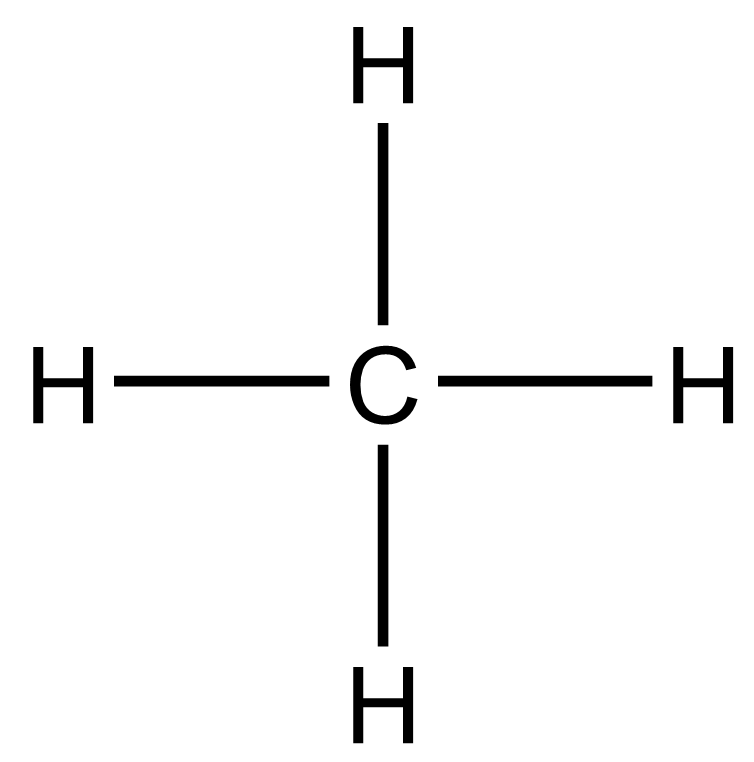
- Determine remaining electrons and distribute evenly on terminal atoms. For CH4 there are no remaining electrons.
With no electrons remaining this means there is also no step 5. for CH4 and we would move on to calculating formal charge (Step 6.).
- In determining formal charges for the atoms in CH4, we have to calculate the formal charge of each atom individually. Calculating the formal charge for H should be relatively easy. H, being in n=1 should only ever make 1 single bond, so our formal charge calculation should be that $1-1=0$. A carbon has 4 valence electrons, and in this structure carbon has zero lone pairs and 4 bonds our equation will be:
So all formal charges in the structure we drew for CH4 will be zero. By determining this and previously that all atoms have an octet/duet we can conclude that we have drawn a correct structure for methane, CH4.
Next let us draw the Lewis structure for NH2–. For step #1 to test your understanding of determining the total electron count complete the following multiple choice question:
Now that you know the correct electron count for NH2–, Let’s use steps 2-5 to complete the Lewis skeleton, before assigning formal charge:
Now that you have the correct skeleton, which of the following statements in this multiple choice question correctly states all the formal charges on the atoms:
Now let us now move onto a slightly more complex example with methanol, CH3OH:
To test our understanding on this a bit more try these four quick simple Lewis structures in the following quiz:
With N2O we start to run into the struggle of assigning which atom goes where and what bonding arrangement to use. Complete the following activity to get a better understanding of this idea:
As you saw there were 4 key points to take away from that activity:
- The best Lewis Structure minimizes formal charges as much as possible.
- Usually putting the least electronegative atom or atom that needs the most bonds to complete the octet as the central atom first will most often lead to the Best Lewis Structure.
- When formal charges cannot be fully eliminated, place a negative formal charge on the most electronegative atom and a positive formal charge on the least electronegative atom.
- A curly/curvy arrow can show the movement of two electrons, in this case, to go from a lone pair to form a multiple bond. See more on curly arrows [here].
Check Your Learning
Both carbon monoxide, CO, and carbon dioxide, CO2, are products of the combustion of fossil fuels. Both of these gases also cause problems: CO is toxic and CO2 has been implicated in global climate change. What are the Lewis structures of these two molecules?
Fullerene Chemistry
Carbon soot has been known to man since prehistoric times, but it was not until fairly recently that the molecular structure of the main component of soot was discovered. In 1996, the Nobel Prize in Chemistry was awarded to Richard Smalley ([link]), Robert Curl, and Harold Kroto for their work in discovering a new form of carbon, the C60 buckminsterfullerene molecule ([link]). An entire class of compounds, including spheres and tubes of various shapes, were discovered based on C60. This type of molecule, called a fullerene, shows promise in a variety of applications. Because of their size and shape, fullerenes can encapsulate other molecules, so they have shown potential in various applications from hydrogen storage to targeted drug delivery systems. Unique electronic and optical properties contribute to the effective use of these materials in solar-powered devices and chemical sensors.

Key Concepts and Summary
Valence electronic structures can be visualized by drawing Lewis symbols (for atoms and monatomic ions) and Lewis structures (for molecules and polyatomic ions). Lone pairs, unpaired electrons, and single, double, or triple bonds are used to indicate where the valence electrons are located around each atom in a Lewis structure. Most structures—especially those containing second row elements—follow the octet rule, where every atom (except H) is surrounded by eight electrons.
Next we will introduce exceptions to the octet rule that occur for odd-electron molecules (free radicals), electron-deficient molecules, and hypervalent molecules.